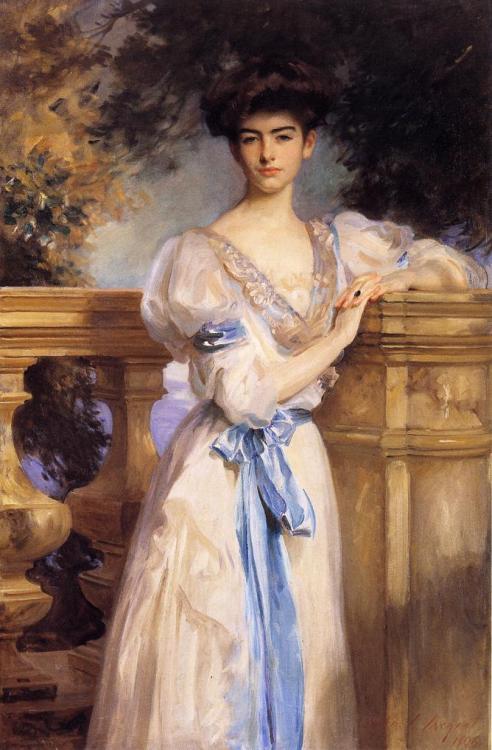Count and Countess László Széchenyi, circa 1908. In my…
Thursday, August 29th, 2013
Count and Countess László Széchenyi, circa 1908.
In my headcanon, they’re staring down an early papparazzo.
Reposted from http://lies.tumblr.com/post/59664129050.

Count and Countess László Széchenyi, circa 1908.
In my headcanon, they’re staring down an early papparazzo.
Reposted from http://lies.tumblr.com/post/59664129050.

lies:
John Singer Sargent
All the Sargent.
Reblogging myself to add more about the painting:
Gladys Vanderbilt, 1906
Gladys Moore Vanderbilt was born in 1886, the youngest of seven siblings. She was a member of the wealthy New York Vanderbilts, great-granddaughter of shipping and railroad magnate Cornelius Vanderbilt. She turned 20 the year this portrait was painted.
Two years later, on January 27, 1908, she married a Hungarian count, László Széchenyi. She was 22, he was 28. The wedding took place in New York, and was much discussed in the Times. This article [PDF] ran the day before the wedding:
Long and Illustrious Record of the Ancient Hungarian Family Into Which Mis Gladys Vanderbilt will be Married To-morrow
The wedding of Count Laszlo Széchényi and Miss Gladys Moore Vanderbilt will take place precisely at 12 to-morrow in the large ballroom of Mrs. Vanderbilt’s New York home, at Fifty-eighth Street and Fifth Avenue. Mgr. Lavelle of St. Patrick’s Cathedral will be the only clergyman, and the ceremony is to be the simplest possible. It will be followed at 12:30 by the breakfast for 150 guests…
Miss Gladys Moore Vanderbilt is the sixth and youngest child of the late Cornelius Vanderbilt. Her mother was a Miss Gyynne, a member of a Western family. All her brothers and sisters but one are living… Despite their large wealth and their two magnificently appointed houses — palaces rather — in Newport and New York, Mr. and Mrs. Vanderbilt never gave elaborate or large entertainments or assumed any place as leaders in any sense in society. They were devoted churchgoers, most simple and unaffected in their tastes, and brought up their children in the same fashion.
It was not until Miss Gladys Vanderbilt made her debut two or three years ago that Mrs. Vanderbilt gave a large dance at her town house. The death shortly after of her brother, Edward Gwynne, threw her again into mourning, and it was not only the first but the last large entertainment in town. Since the death of Cornelius Vanderbilt several years ago she has, with Miss Gladys, spent much time abroad.
The next day’s paper carried a full account of the wedding, including illustrations, play-by-play of the ceremony, and a lengthy guest list: Miss Vanderbilt Now a Countess [PDF]. An excerpt:
Her wedding day was cloudless. The ceremony was of the simplest character, and was witnessed by more than 400 relatives and friends of the two families.
Immediately after the wedding breakfast the Count and Countess left for their honeymoon. To say that they left precipitately is keeping strictly to the truth. They gave the slip to a small army of reporters and photographers who had formed a cordon around the house, bent on capturing the bridal pair for an instant.
With much ostentation a Vanderbilt brougham was driven up to the Fifty-seventh Street entrance, and this was accepted instantly as the signal that the bridal pair would come out there. Perched on the box were a coachman and a footman in the Vanderbilt livery of dark crimson with claret-colored collar.
Within a few seconds the light brigade of reporters and snap-shotters had concentrated its whole force in range of that showy brougham. Every foot of available space was pre-empted and every vantage point filled.
With this snare set, Alfred G. Vanderbilt suddenly drove up to the Fifty-eighth Street entrance in a big Limousine touring car. Just as the car came to a halt, the doors swung open and down the steps tripped the bride with the Count in a big overcoat and derby hat close behind.
Almost before it dawned on the throngs about the house that it was the bride and bridegroom the door of the touring car had slammed shut and the big machine was scooting through Fifty-eighth Street toward Lexington Avenue. Less than two minutes later it had vanished from sight. An hour later the foremost of the pursuing vehicles reported that it had lost track of the bridal couple in Mott Haven.
The couple went on to have five children, all daughters. They spent most of their time in Hungary, where the Count owned two great estates. He died in 1938 at the age of 59. The Countess lived another 27 years, dying in 1965 in Washington, D.C., on the day after what would have been her 57th wedding anniversary.
Reposted from http://lies.tumblr.com/post/59663906398.